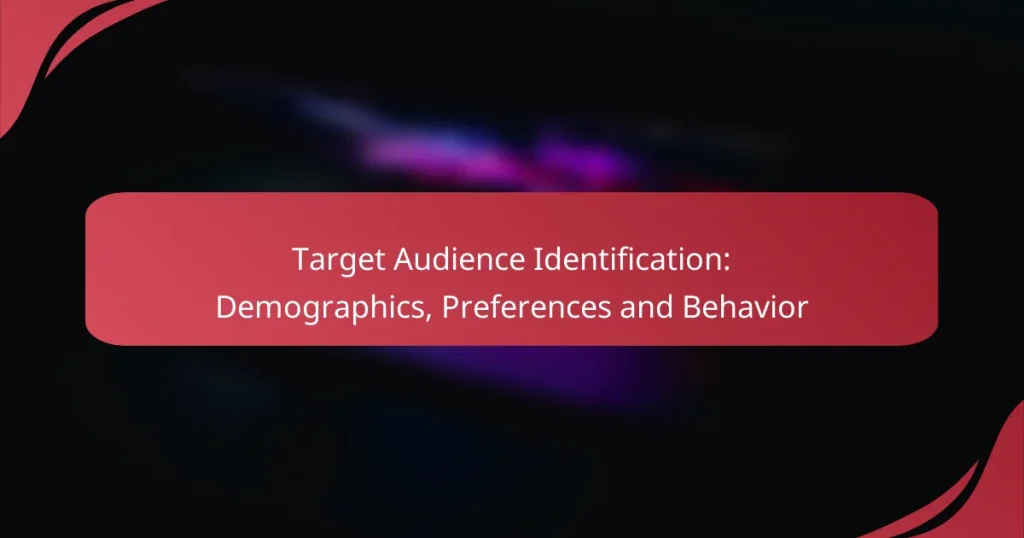Identifying the target audience in e-commerce is crucial for effective marketing and product development. By analyzing demographics, preferences, and consumer behavior, businesses can create tailored strategies that resonate with potential customers, enhancing their shopping experience and driving sales. Understanding these elements allows companies to meet the specific needs of their audience, fostering loyalty and satisfaction.

How to identify target audience demographics in e-commerce?
Identifying target audience demographics in e-commerce involves analyzing key characteristics such as age, gender, income, and geographic location. This understanding helps tailor marketing strategies and product offerings to better meet the needs of potential customers.
Age distribution analysis
Age distribution analysis helps e-commerce businesses understand the age groups that are most likely to purchase their products. This can be achieved through surveys, website analytics, and sales data, which often reveal trends in purchasing behavior across different age ranges.
For example, if a brand sells tech gadgets, it may find that customers aged 18-34 make up a significant portion of their sales. This insight allows businesses to create targeted marketing campaigns that resonate with younger consumers, such as using social media platforms popular among this demographic.
Gender segmentation
Gender segmentation involves categorizing potential customers based on their gender to tailor marketing efforts effectively. E-commerce platforms can analyze purchase history and website traffic to determine the gender distribution of their audience.
For instance, a clothing retailer may discover that a majority of its customers are female. This information can inform product selection, promotional strategies, and advertising channels, ensuring that marketing messages appeal specifically to the predominant gender of their audience.
Income level assessment
Income level assessment is crucial for understanding the purchasing power of your target audience. By analyzing customer data, businesses can segment their audience into different income brackets, which helps in pricing strategies and product offerings.
For example, a luxury brand may target consumers with higher disposable incomes, while a discount retailer may focus on budget-conscious shoppers. Knowing the income levels of your audience can guide promotional tactics, such as offering financing options for higher-priced items.
Geographic location insights
Geographic location insights provide valuable information about where your customers are located, influencing shipping strategies, marketing campaigns, and product availability. Analyzing sales data by region can reveal trends and preferences unique to specific areas.
For instance, a business selling winter apparel may find higher sales in colder regions during the winter months. This knowledge allows for targeted advertising in those areas and the potential to stock region-specific products, enhancing customer satisfaction and sales performance.

What are the key audience preferences for online shopping?
Key audience preferences for online shopping include convenience, variety, and personalized experiences. Shoppers increasingly seek platforms that offer a seamless experience, competitive pricing, and products that meet their specific needs.
Brand loyalty factors
Brand loyalty in online shopping is influenced by factors such as trust, quality of customer service, and consistent product availability. Customers tend to remain loyal to brands that provide reliable delivery, easy returns, and responsive support.
Additionally, loyalty programs and personalized marketing can strengthen this bond. For example, offering exclusive discounts or rewards for repeat purchases can encourage customers to choose one brand over another.
Product quality expectations
Consumers expect high product quality when shopping online, often relying on reviews and ratings to guide their decisions. A significant number of shoppers will avoid brands with poor reviews, even if the price is attractive.
To meet these expectations, businesses should prioritize quality control and transparency. Providing detailed product descriptions, high-resolution images, and customer testimonials can help build confidence in the product’s quality.
Price sensitivity trends
Price sensitivity among online shoppers varies widely, but many consumers are increasingly looking for the best deals. Discounts, promotions, and price comparisons are crucial in attracting price-sensitive customers.
Businesses should consider implementing dynamic pricing strategies and offering limited-time promotions to capture this audience. Additionally, providing clear information about shipping costs and return policies can help mitigate concerns about overall expenses.

How to analyze consumer behavior in e-commerce?
Analyzing consumer behavior in e-commerce involves understanding how customers interact with online stores, including their shopping habits, decision-making processes, and reasons for abandoning carts. This analysis helps businesses tailor their strategies to meet customer needs and improve sales performance.
Shopping frequency patterns
Shopping frequency patterns refer to how often consumers make purchases within a specific timeframe. Understanding these patterns can help businesses identify peak shopping times and tailor marketing efforts accordingly. For instance, customers may shop more frequently during holiday seasons or promotional events.
To analyze shopping frequency, track metrics such as average purchase intervals and seasonal trends. This data can reveal whether customers prefer to shop weekly, monthly, or during specific sales events, allowing for targeted promotions that align with their habits.
Purchase decision influences
Purchase decision influences encompass the factors that affect how consumers decide to buy products. These can include price, product reviews, brand reputation, and social media recommendations. Understanding these influences enables businesses to optimize their offerings and marketing strategies.
For example, offering competitive pricing or showcasing positive customer testimonials can significantly impact a consumer’s decision to complete a purchase. Additionally, leveraging social proof through influencer partnerships may enhance credibility and encourage sales.
Cart abandonment reasons
Cart abandonment occurs when customers add items to their online shopping carts but fail to complete the purchase. Common reasons for this behavior include unexpected shipping costs, complicated checkout processes, and concerns about payment security. Identifying these reasons is crucial for reducing abandonment rates.
To address cart abandonment, consider implementing strategies such as transparent pricing, simplifying the checkout process, and offering multiple secure payment options. Sending follow-up emails with reminders or incentives can also encourage customers to finalize their purchases.

What tools can help in audience identification?
Several tools can assist in audience identification by providing insights into demographics, preferences, and behaviors. Utilizing these tools effectively can help businesses tailor their marketing strategies to better meet the needs of their target audience.
Google Analytics for demographics
Google Analytics is a powerful tool that offers detailed demographic data about website visitors, including age, gender, and geographic location. By setting up demographic reports, businesses can gain insights into who their audience is and how they interact with their content.
To get started, enable the demographics and interests reports in your Google Analytics account. This data can reveal trends and help identify which segments of your audience are most engaged, allowing for targeted marketing efforts.
Survey tools for preferences
Survey tools like SurveyMonkey or Google Forms can be invaluable for gathering direct feedback on audience preferences. These platforms allow businesses to create customized surveys that can reveal insights into customer interests, needs, and satisfaction levels.
When designing surveys, keep questions clear and concise. Aim for a mix of multiple-choice and open-ended questions to capture both quantitative and qualitative data. Offering incentives for participation can also increase response rates.
Social media insights platforms
Social media insights platforms, such as Facebook Insights or Twitter Analytics, provide valuable information about audience engagement and behavior on social networks. These tools can help identify which content resonates most with your audience and how they interact with your brand online.
Regularly reviewing these insights can inform your content strategy and help optimize your social media campaigns. Pay attention to metrics like engagement rates, shares, and audience demographics to refine your approach and better connect with your target audience.

How to create audience personas for e-commerce?
Creating audience personas for e-commerce involves identifying and detailing the characteristics of your target customers. These personas help tailor marketing strategies, product offerings, and customer experiences to meet specific needs and preferences.
Defining persona attributes
Defining persona attributes requires gathering data on demographics, preferences, and behaviors of potential customers. Key attributes include age, gender, income level, education, and geographic location, which can significantly influence purchasing decisions.
Consider using surveys, interviews, and analytics tools to collect this information. For example, if your e-commerce store sells outdoor gear, you might find that your primary audience is males aged 25-40 with a moderate to high income who live in suburban areas.
Additionally, explore psychographic factors such as interests, values, and lifestyle choices. This deeper understanding allows for more personalized marketing efforts, enhancing customer engagement and loyalty.


